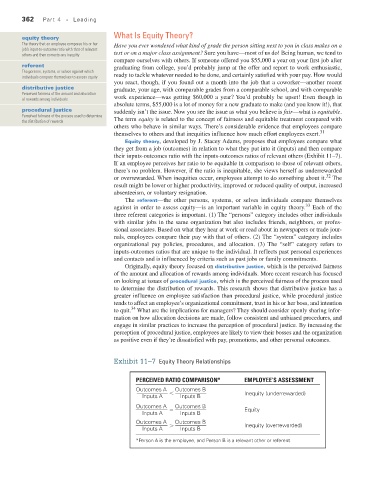Page 363 - Fundamentals of Management Myths Debunked (2017)_Flat
P. 363
362 Part 4 • Leading
What Is Equity Theory?
equity theory
The theory that an employee compares his or her Have you ever wondered what kind of grade the person sitting next to you in class makes on a
job’s input-to-outcome ratio with that of relevant test or on a major class assignment? Sure you have—most of us do! Being human, we tend to
others and then corrects any inequity
compare ourselves with others. If someone offered you $55,000 a year on your first job after
referent graduating from college, you’d probably jump at the offer and report to work enthusiastic,
The persons, systems, or selves against which ready to tackle whatever needed to be done, and certainly satisfied with your pay. How would
individuals compare themselves to assess equity
you react, though, if you found out a month into the job that a coworker—another recent
distributive justice graduate, your age, with comparable grades from a comparable school, and with comparable
Perceived fairness of the amount and allocation work experience—was getting $60,000 a year? You’d probably be upset! Even though in
of rewards among individuals
absolute terms, $55,000 is a lot of money for a new graduate to make (and you know it!), that
procedural justice suddenly isn’t the issue. Now you see the issue as what you believe is fair—what is equitable.
Perceived fairness of the process used to determine The term equity is related to the concept of fairness and equitable treatment compared with
the distribution of rewards
others who behave in similar ways. There’s considerable evidence that employees compare
themselves to others and that inequities influence how much effort employees exert. 31
Equity theory, developed by J. Stacey Adams, proposes that employees compare what
they get from a job (outcomes) in relation to what they put into it (inputs) and then compare
their inputs-outcomes ratio with the inputs-outcomes ratios of relevant others (Exhibit 11–7).
If an employee perceives her ratio to be equitable in comparison to those of relevant others,
there’s no problem. However, if the ratio is inequitable, she views herself as underrewarded
32
or overrewarded. When inequities occur, employees attempt to do something about it. The
result might be lower or higher productivity, improved or reduced quality of output, increased
absenteeism, or voluntary resignation.
The referent—the other persons, systems, or selves individuals compare themselves
33
against in order to assess equity—is an important variable in equity theory. Each of the
three referent categories is important. (1) The “persons” category includes other individuals
with similar jobs in the same organization but also includes friends, neighbors, or profes-
sional associates. Based on what they hear at work or read about in newspapers or trade jour-
nals, employees compare their pay with that of others. (2) The “system” category includes
organizational pay policies, procedures, and allocation. (3) The “self” category refers to
inputs-outcomes ratios that are unique to the individual. It reflects past personal experiences
and contacts and is influenced by criteria such as past jobs or family commitments.
Originally, equity theory focused on distributive justice, which is the perceived fairness
of the amount and allocation of rewards among individuals. More recent research has focused
on looking at issues of procedural justice, which is the perceived fairness of the process used
to determine the distribution of rewards. This research shows that distributive justice has a
greater influence on employee satisfaction than procedural justice, while procedural justice
tends to affect an employee’s organizational commitment, trust in his or her boss, and intention
34
to quit. What are the implications for managers? They should consider openly sharing infor-
mation on how allocation decisions are made, follow consistent and unbiased procedures, and
engage in similar practices to increase the perception of procedural justice. By increasing the
perception of procedural justice, employees are likely to view their bosses and the organization
as positive even if they’re dissatisfied with pay, promotions, and other personal outcomes.
Exhibit 11–7 Equity Theory Relationships
PeRceIved RATIo coMPARISoN* eMPloYee’S ASSeSSMeNT
Outcomes A Outcomes B
Inputs A 6 Inputs B Inequity (underrewarded)
Outcomes A Outcomes B
Inputs A = Inputs B Equity
Outcomes A Outcomes B Inequity (overrewarded)
Inputs A 7 Inputs B
*Person A is the employee, and Person B is a relevant other or referent.

